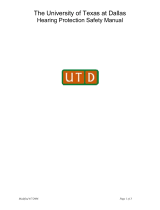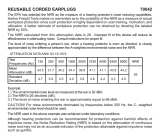
Noise & Health, March-April 2011, Volume 13
174
to obtain a higher degree of precision. However, as our
experiments indicate, the largest portion of the uncertainty is
in the tting variability. Regardless of how the measurements
are taken, whether with objective systems such as the one
in this study or by subjective eld attenuation measurement
systems, tting variability is inherent in the application of
hearing protection devices to real ears. This uncertainty can
be acknowledged and, if need be, addressed by requiring
repeat measurements until the desired precision is achieved.
The value of the F-MIRE system is that its speed makes such
repeat measurements feasible. Besides, in practice, the repeat
measurements serve the added benet of providing additional
practice for employees to improve their tting technique and
enhance the likelihood of obtaining adequate protection from
their earplug of choice.
Additional comments
A factor not fully accounted for in the experiments reported
herein is validation of the measurement uncertainty with
actual employees in a hearing conservation program or
with subjects meeting the requirements of the Method B
protocol of ANSI S12.6-2008. That was not feasible in these
experiments because of the requirements for subject retention
and, regardless, the requirements for inexperience would
have been abrogated by the multiple re-tests needed in this
study. At a future time, we envision testing uncertainty with
a revised protocol and Method B-type subjects.
An important issue in designing probes for the foam plugs
was to assure that the tubing was sufciently narrow and soft
and that it did not affect the ability to roll down the product for
proper insertion. The probes that were developed were found
to be quite usable in our experiments. It is unclear however
whether the tubing would affect the ability of inexperienced
subjects to properly insert the plug. We hope to also test
that in a Method B protocol by comparing the REAT values
for inexperienced users inserting sealed-tubed plugs and
unmodied plugs. However, if the tubing is found to be a
problem, it is most likely a “safe” error that would interfere
with rather than enhance the ability to insert the plugs.
Thus, if the subject can obtain adequate F-MIRE measured
protection with the tubed product, she/he will likely do so
with the unmodied plug as well.
As the F-MIRE process becomes more widely applied in
practice, we anticipate providing guidance on the degree
of uncertainty and how it varies with repeat measurements.
The recommendations may be application specic and
dependent on the level of noise exposure. Additionally,
efforts are underway in the ANSI working group S12/WG11
on hearing protectors to develop a standard that species
how uncertainty shall be measured and reported in eld
measurement attenuation systems
[9]
such as the F-MIRE
system discussed in this study.
Meanwhile, the hearing conservationist now has available a
portable, convenient, quick, and easy-to-use system that can be
implemented in programs to improve training and motivation
of employees, aid in the assignment of HPDs based on noise
exposures, and address other hearing conservation program
management and compliance issues.
Address for correspondence:
E. H. Berger,
3M Occupational Health and Environmental Safety
Division, E•A•RCAL Laboratory, 7911 Zionsville Road,
Indianapolis, IN 46268-1657, USA.
References
1. Royster LH, Royster JD. An overview of hearing conservation practices
in the USA. J Acoust Soc Am 1999;105:1009.
2. Gauger D, Berger EH. A new hearing protector rating: The Noise
Reduction Statistic use with A-weighting (NRS
A
),” a report prepared
at the request of the U. S. Environmental Protection Agency, reviewed
and approved by ANSI S12/WG11, E-A-R 04-01/HP, Indianapolis,
IN, 2004.
3. Berger EH. Assessment of the performance of hearing protectors for
hearing conservation purposes. Noise Vib Cont Worldwide 1984;15:75-81.
4. Berger EH. Methods of measuring the attenuation of hearing protection
devices. J Acoust Soc Am 1986;79:1655-87.
5. Berger EH. Use of circumaural and supra-aural earphones to measure
the real-ear attenuation of earplugs. San Francisco, CA: Am Ind Hyg
Conf; 1988. paper 39.
6. Berger EH. Exploring procedures for eld testing the t of earplugs.
In: Proceedings, 1989 Industrial Hearing Conservation Conference.
Lexington, KY: Off. Eng. Serv., Univ. Kentucky; 1989. p. 7-10.
7. Berger EH. Introducing F-MIRE testing - background and concepts.
E•A•R Tech. Rept. 06-29/HP, Indianapolis, IN, Aearo Technologies,
2006.
8. Hager LD, Voix J. Individual eld t testing of hearing protectors – a
eld-MIRE approach,” Conf. American Society of Safety Engineers.
Seattle, WA: ASSE; 2006.
9. ANSI. Performance criteria and uncertainty determination for individual
hearing protector eld attenuation measurement devices. New York,
NY: American National Standards Institute; S12.71-201X (draft).
10. ANSI. Methods for the measurement of insertion loss of hearing
protection devices in continuous or impulsive noise using microphone-
in-real-ear or acoustic test xture procedures. New York, NY: American
National Standards Institute; S12.42-2010.
11. Voix J, Laville F. Expandable earplug with smart custom tting
capabilities. In Proceedings of InterNoise 02, Poughkeepsie, NY: Noise
Control Foundation; 2002.
12. Voix J, Laville F. New method and device for customizing in situ a hearing
protector. Canadian Acoust 2004;32:86-7.
13. Voix J, Laville F. The objective measure of individual earplug eld
performance. J Acoust Soc Am 2009;125:3722-32.
14. ANSI. Methods of estimating effective A-weighted sound pressure levels
when hearing protectors are worn. New York, NY: American National
Standards Institute; S12.68-2007.
15. Voix J, Hager LD. Individual t testing of hearing protection devices. Int
J Occup Saf Ergon 2009;15:211-9.
16. Michael PL, Kerlin RL, Bienvenue GR, Prout JH, Shampan JI. A real-ear
eld method for the measurement of the noise attenuation of insert-type
hearing protectors. Rept. No. 76-181, Cincinnati, OH, National Institute
for Occupational Safety and Health, U.S. Dept. of HEW, 1976.
17. ANSI. Methods for measuring the real-ear attenuation of hearing
protectors. New York, NY: American National Standards Institute;
S12.6-2008.
Berger, et al.: Development and validation of an F-MIRE approach ...

















